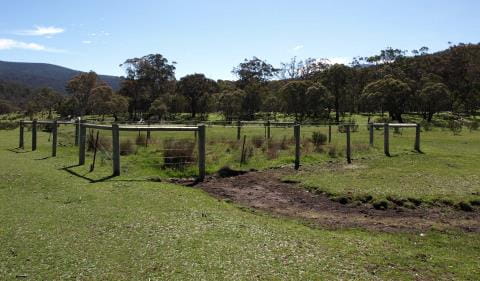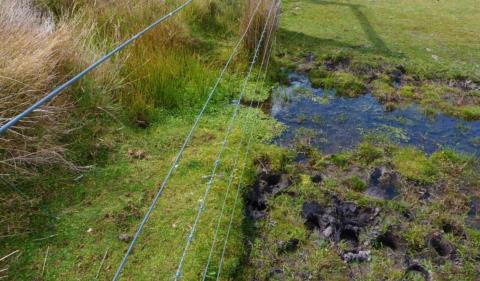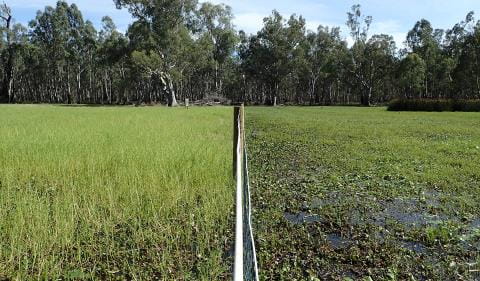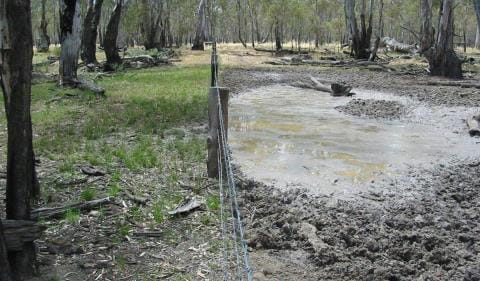Feral horses
Horses are not a natural part of the Australian environment.
Their hard hooves can cause serious damage to delicately balanced ecosystems, native plants and native animals. They destroy habitat critical to many threatened plant and animal species by eating and degrading fragile vegetation, damaging waterways, and disturbing soil to cause erosion and compaction.
Parks Victoria works with community and experts to design and deliver programs that can help control feral horse populations.
FAQs about feral horses
Visit Feral horse FAQs for the answers to frequently asked questions about feral horses in Victoria.
Managing feral horse populations in Victoria
Parks Victoria aims to reduce the numbers of feral horses in parks, to protect the natural environment and provide a greater chance of survival for native species, many of which are found nowhere else on the planet.
Feral horses are being removed from parks through targeted ground-shooting by professionals under strict protocols and oversight, and trapping and rehoming, if it is feasible, safe and humane to do so, and if there is sufficient demand from organisations or individuals that can suitably care for the captured horses. Aerial shooting may be considered in exceptional circumstances, or may be trialled if other methods fail to remove sufficient horses to reduce ecological impacts.
In some places, small-scale exclusion areas are fenced to protect small vulnerable habitats and to collect information on what the environment should look like without pressure from feral horses.
All feral horse management operations are thoroughly planned and implemented under strict protocols and oversight, ensuring that operations are safe, effective, humane and meet obligations of all relevant legislation, Codes of Practice and Standard Operating Procedures.
Note: To protect the safety and welfare of Parks Victoria staff, contractors and community members, operational details (such as timing and location of feral horse control operations) are not publicly released.
Rehoming
Where it is feasible, safe and humane to trap feral horses, and if there is sufficient demand and commitment to rehome them, Parks Victoria will endeavour to trap feral horses and offer them to organisations or individuals that can provide suitable care. Parks Victoria is committed to rehoming feral horses to the extent that suitable rehoming applicants can be found. Find out more about our rehoming program at Rehoming a feral horse.
Barmah National Park
Parks Victoria released the Strategic Action Plan: Protection of floodplain marshes in Barmah National Park and Barmah Forest Ramsar site [2020-2023] in February 2020. The plan outlined a four-year program to address threats in the Barmah National Park and protect it for current and future generations.
The plan was extended through to June 2024, pending a review to assess progress.
The Strategic Action Plan Evaluation has been completed and has found the Strategic Action Plan to have been largely successful in its aim to improve the health of the floodplain marshes of Barmah Forest within Barmah National Park, by addressing each of the threatening processes impacting them. The evaluation made a number of recommendations which have all been accepted.
Ongoing actions for the continued recovery of the floodplain marshes, including the removal of feral horses, and the eradication or reduction of other introduced herbivore populations, including feral pigs and deer, will be further progressed under other existing management plans.
Parks Victoria will continue its actions towards achieveing the long-term goal of reducing the feral horse population to zero, primarily through targeted ground-shooting by appropriately accredited professionals under strict protocols and oversight. Feral horses will only be trapped and rehomed if it is feasible, safe and humane to do so, and if there is sufficient demand from organisations or individuals that can suitably care for the captured horses.
Barmah National Park covers most of the area of the Barmah Forest Ramsar site which supports nearly 300 native species of birds, fishes, reptiles, frogs and other animals and more than 500 native plant species. This includes endangered or vulnerable species such as the Australasian bittern, Superb parrot, Murray cod, Silver perch, Trout cod, Mueller daisy and Swamp wallaby grass. By implementing the Strategic Action Plan, we will better protect the ecosystem that supports these species in the internationally significant wetlands within Barmah National Park.
Alpine National Park
Parks Victoria released the Feral Horse Action Plan 2021 on 1 November 2021. The plan outlines the approach to managing feral horses in the Alpine National Park and adjacent state forests over a ten-year period.
The purpose of this plan is to improve the management of feral horses in the Alpine National Park, and reduce the damage they cause to vulnerable natural and Aboriginal cultural values, and water and catchment qualities of the Victorian Alps. The need for a revision of the 2018-21 Action Plan was also driven by increases in the size and distribution of feral horse populations, the impact on habitats from the 2019-20 Black Summer bushfires and the limitations of management methods that have been used.
As feral horses are well-established across large areas of remote terrain of the eastern Alps, they are unlikely to be completely removed. Through reducing their numbers, Parks Victoria is working to give native species at risk of extinction a greater chance of survival.


Exclosure fencing demonstrating horse impacts in the Alpine National Park (above) and Barmah National Park (below)


These fenced plots clearly show the damage caused primarily by feral horses. Within fenced areas, vegetation and waterways are intact. Outside the fences, there is large loss of vegetation and ground cover, as well as damage to soil and waterways.
Horse control program
January 2020 to May 2025
| Ground shooting | Trapped and rehomed | Euthanased following welfare check | Total | |
| Barmah National Park | 620 | 43* | 48 | 711 |
| Alpine National Park | 1708 | 3 | 0 | 1711 |
| Totals | 2328 | 46 | 48 | 2422 |
*During this time an additional 39 trapped horses were refused by rehomers as they did not fit their preference for age or gender and had to be released back to the park, as the only safe and humane option under the circumstances.
No horses removed during the control program have been sent to knackeries.
Feral horses damage Victoria’s natural environment
For millions of years, Victoria's native plants and animals evolved to survive in our unique environments, without the impacts of feral animals. Victoria’s native plants and animals, many of which are found nowhere else on the planet, are not equipped to deal with the weight, grazing, hard hooves or trampling of feral horses.
Feral horses are present in significant numbers in two areas managed by Parks Victoria - the Victorian Alps (particularly the Alpine National Park) and Barmah National Park. The populations in these areas are not contained and do not currently occupy their entire potential range.
Feral horses cause damage by:
- grazing and browsing – they consume native plants and destroy the habitat of native wildlife.
- pugging and streambank collapse – they compact soil, increase erosion, cause wet areas to dry out and degrade waterways.
- impacting water quality – they remove vegetation, reduce water filtering, cause muddier water and harm native aquatic species.
- creating trackways – they increase erosion and spread weeds and diseases.
- trampling and opening bare ground – they harm soil and plant growth.
- producing dung piles – that suffocate native plants and helps weed dispersal.
- spreading weeds – that displace native plants.
- competing for habitat and food - native animals suffer from damaged habitat and less available food.
- impacting visitor experience - while some visitors seek or enjoy seeing horses in the Alpine National Park, the presence of feral horse can conflict with other visitors’ expectations of a natural environment and the key features of national parks.
Alpine National Park
The Victorian Alps is home to native plant and animal species that occur nowhere else in the world. Unique plant communities including alpine sphagnum moss peatlands, snowpatch communities, and associated wetland bogs are threatened at both state and national levels. These vegetation communities are critical for maintaining the quality and gradual release of water supply into the Murray River, one of Australia’s most important sources of fresh water.
Some of the native animals living in this area only exist in tiny, remote patches within the Alps. They rely on healthy plant communities, clean water and stable streambanks to provide food and shelter in the harsh alpine environment.
From surveys conducted on the Bogong High Plains and in the eastern Alps in 2021, the number of feral horses in the Victorian Alps was estimated as approximately 2,700.
Barmah National Park
Barmah National Park, east of Echuca on the Murray River, is jointly managed by Parks Victoria and the Traditional Owners, the Yorta Yorta nation. The ecological health of the area is essential to Traditional Owners’ cultural and spiritual connections to the land and it supports valuable recreation and tourism activity.
Barmah National Park and the Barmah Forest site is of great importance for waterbirds and provides habitat for many wetland-dependent wildlife species, including nearly 300 native species of birds, fishes, reptiles, frogs and other animals and more than 500 native plant species. These wetland values must be maintained to meet Victoria’s international treaty obligations under the Ramsar Convention.
It is one of the few places in Australia where Moira grass exists. Moira grass, a critically important native wetland grass species, used to dominate the area but has suffered a dramatic decline over the past few decades. It has a high nutrient content and is targeted by grazing herbivores, particularly by feral horses.
From a survey conducted in November 2021, it was estimated that there were approximately 330 feral horses in Barmah National Park.
Understanding the feral horse population
For more information about feral horse survey methods and results for the Alpine and Barmah National Parks, visit Victorian surveys on feral horses.
Obligations to manage feral horses
Parks Victoria has clear legal obligations to protect and manage Victoria’s natural environment, and specifically the parks estate. These obligations are set out in a range of legislation including:
- Parks Victoria Act 2018
- National Parks Act 1975 (Vic)
- Flora and Fauna Guarantee Act 1988 (Vic)
- Environment Protection and Biodiversity Conservation Act 1999 (Cth)
- International Ramsar Wetlands Convention
For some members of the public and community groups, horses provide a living link to Victorian pioneer and grazing history in the Alps and the Barmah region. Management of horses in national parks and public lands must balance three elements: the right level of protection for our natural environment and pre-European cultural heritage; the humane treatment of feral horses; and social expectations for either a continued heritage connection to the ‘brumby’ or their management.
Parks Victoria acknowledges the value placed on feral horses by some members of the community. However, Parks Victoria has legal and moral obligations to protect the native species that are at risk of extinction from the impacts of feral horses and other pest animals.

